
16??" Floor Model Drill Press
(Model DP400)
PART NO. A10352 -
Copyright ?? 2005 Delta Machinery
please call
MANUAL INSTRUCTION

16??" Floor Model Drill Press
(Model DP400)
PART NO. A10352 -
Copyright ?? 2005 Delta Machinery
please call
MANUAL INSTRUCTION
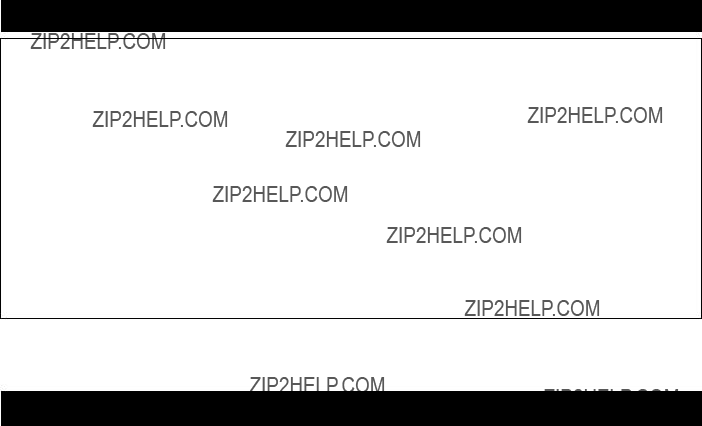
IMPORTANT SAFETY INSTRUCTIONS
 Read and understand all warnings and operating instructions before using any tool or equipment. When using tools or equipment, basic safety precautions should always be followed to reduce the risk of personal injury. Improper operation, maintenance or modification of tools or equipment could result in serious injury and property damage. There are certain applications for which tools and equipment are designed. Delta Machinery strongly recommends that this product NOT be modified and/or used for any application other than for which it was designed.
Read and understand all warnings and operating instructions before using any tool or equipment. When using tools or equipment, basic safety precautions should always be followed to reduce the risk of personal injury. Improper operation, maintenance or modification of tools or equipment could result in serious injury and property damage. There are certain applications for which tools and equipment are designed. Delta Machinery strongly recommends that this product NOT be modified and/or used for any application other than for which it was designed.
If you have any questions relative to its application DO NOT use the product until you have written Delta Machinery and we have advised you.
Online contact form at www.deltamachinery.com
Postal Mail: Technical Service Manager
Delta Machinery
4825 Highway 45 North
Jackson, TN 38305
(IN CANADA: 505 SOUTHGATE DRIVE, GUELPH, ONTARIO N1H 6M7)
Information regarding the safe and proper operation of this tool is available from the following sources:
Power Tool Institute
1300 Sumner Avenue, Cleveland, OH
National Safety Council
1121 Spring Lake Drive, Itasca, IL
American National Standards Institute, 25 West 43rd Street, 4 floor, New York, NY 10036 www.ansi.org ANSI 01.1Safety Requirements for Woodworking Machines, and
the U.S. Department of Labor regulations www.osha.gov
SAVE THESE INSTRUCTIONS!
2
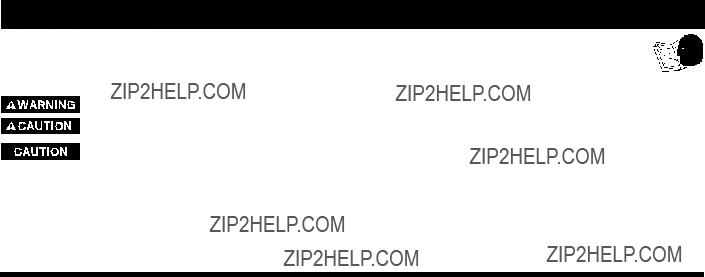
SAFETY GUIDELINES - DEFINITIONS
It is important for you to read and understand this manual. The information it contains relates to protecting YOUR SAFETY and PREVENTING PROBLEMS. The symbols below are used to help you recognize this information.
 Indicates an imminently hazardous situation which, if not avoided, will result in death or serious injury. Indicates a potentially hazardous situation which, if not avoided, could result in death or serious injury.
Indicates an imminently hazardous situation which, if not avoided, will result in death or serious injury. Indicates a potentially hazardous situation which, if not avoided, could result in death or serious injury.
Indicates a potentially hazardous situation which, if not avoided, may result in minor or moderate injury.
Used without the safety alert symbol indicates potentially hazardous situation which, if not avoided, may result in property damage.
CALIFORNIA PROPOSITION 65
 SOME DUST CREATED BY POWER SANDING, SAWING, GRINDING, DRILLING, AND OTHER CONSTRUCTION ACTIVITIES contains chemicals known to cause cancer, birth defects or other reproductive harm. Some examples of these chemicals are:
SOME DUST CREATED BY POWER SANDING, SAWING, GRINDING, DRILLING, AND OTHER CONSTRUCTION ACTIVITIES contains chemicals known to cause cancer, birth defects or other reproductive harm. Some examples of these chemicals are:
??lead from
??crystalline silica from bricks and cement and other masonry products, and
??arsenic and chromium from
Your risk from these exposures varies, depending on how often you do this type of work. To reduce your exposure to these chemicals: work in a well ventilated area, and work with approved safety equipment, always wear NIOSH/OSHA approved, properly fitting face mask or respirator when using such tools.
3

GENERAL SAFETY RULES
 READ AND UNDERSTAND ALL WARNINGS AND OPERATING INSTRUCTIONS BEFORE USING THIS EQUIPMENT. Failure to follow all instructions listed below, may result in electric shock, fire, and/or serious personal injury or property damage.
READ AND UNDERSTAND ALL WARNINGS AND OPERATING INSTRUCTIONS BEFORE USING THIS EQUIPMENT. Failure to follow all instructions listed below, may result in electric shock, fire, and/or serious personal injury or property damage.
IMPORTANT SAFETY INSTRUCTIONS
1.FOR YOUR OWN SAFETY, READ THE INSTRUCTION
MANUAL BEFORE OPERATING THE MACHINE.
Learning the machine???s application, limitations, and specific hazards will greatly minimize the possibility of accidents and injury.
2.WEAR EYE AND HEARING PROTECTION. ALWAYS USE SAFETY GLASSES. Everyday eyeglasses are NOT safety glasses. USE CERTIFIED SAFETY EQUIPMENT. Eye protection equipment should comply with ANSI Z87.1 standards. Hearing equipment should comply with ANSI S3.19 standards.
3.WEAR PROPER APPAREL. Do not wear loose clothing, gloves, neckties, rings, bracelets, or other jewelry which may get caught in moving parts. Nonslip footwear is recommended. Wear protective hair covering to contain long hair.
4.DO NOT USE THE MACHINE IN A DANGEROUS ENVIRONMENT. The use of power tools in damp or wet locations or in rain can cause shock or electrocution. Keep your work area
5.MAINTAIN ALL TOOLS AND MACHINES IN PEAK CONDITION. Keep tools sharp and clean for best and safest performance. Follow instructions for lubricating and changing accessories. Poorly maintained tools and machines can further damage the tool or machine and/or cause injury.
6.CHECK FOR DAMAGED PARTS. Before using the machine, check for any damaged parts. Check for alignment of moving parts, binding of moving parts, breakage of parts, and any other conditions that may affect its operation. A guard or any other part that is damaged should be properly repaired or replaced.
Damaged parts can cause further damage to the machine and/or injury.
7.KEEP THE WORK AREA CLEAN. Cluttered areas and benches invite accidents.
8.KEEP CHILDREN AND VISITORS AWAY. Your shop is a potentially dangerous environment. Children and visitors can be injured.
9.REDUCE THE RISK OF UNINTENTIONAL STARTING.
Make sure that the switch is in the ???OFF??? position before plugging in the power cord. In the event of a power failure, move the switch to the ???OFF??? position. An accidental
10.USE THE GUARDS. Check to see that all guards are in place, secured, and working correctly to reduce the risk of injury.
11.REMOVE ADJUSTING KEYS AND WRENCHES BEFORE STARTING THE MACHINE. Tools, scrap pieces, and other debris can be thrown at high speed, causing injury.
12.USE THE RIGHT MACHINE. Don???t force a machine or an attachment to do a job for which it was not designed. Damage to the machine and/or injury may result.
13.USE RECOMMENDED ACCESSORIES. The use of accessories and attachments not recommended by
Delta may cause damage to the machine or injury to the user.
14.USE THE PROPER EXTENSION CORD. Make sure your extension cord is in good condition. When using an extension cord, be sure to use one heavy enough to carry the current your product will draw. An undersized cord will cause a drop in line voltage, resulting in loss of power and overheating. See the Extension Cord Chart for the correct size depending on the cord length and nameplate ampere rating. If in doubt, use the next heavier gauge. The smaller the gauge number, the heavier the cord.
15.SECURE THE WORKPIECE. Use clamps or a vise to hold the workpiece when practical. Loss of control of a workpiece can cause injury.
16.FEED THE WORKPIECE AGAINST THE DIRECTION OF
THE ROTATION OF THE BLADE, CUTTER, OR ABRASIVE SURFACE. Feeding it from the other direction will cause the workpiece to be thrown out at high speed.
17.DON???T FORCE THE WORKPIECE ON THE MACHINE.
Damage to the machine and/or injury may result.
18.DON???T OVERREACH. Loss of balance can make you fall into a working machine, causing injury.
19.NEVER STAND ON THE MACHINE. Injury could occur if the tool tips, or if you accidentally contact the cutting tool.
20.NEVER LEAVE THE MACHINE RUNNING UNATTENDED. TURN THE POWER OFF. Don???t leave the machine until it comes to a complete stop. A child or visitor could be injured.
21.TURN THE MACHINE ???OFF???, AND DISCONNECT THE MACHINE FROM THE POWER SOURCE before installing or removing accessories, before adjusting or changing
22.MAKE YOUR WORKSHOP CHILDPROOF WITH
PADLOCKS, MASTER SWITCHES, OR BY REMOVING STARTER KEYS. The accidental
23. STAY ALERT, WATCH WHAT YOU ARE DOING, AND
USE COMMON SENSE. DO NOT USE THE
MACHINE WHEN YOU ARE TIRED OR UNDER THE
INFLUENCE OF DRUGS, ALCOHOL, OR MEDICAT- ION. A moment of inattention while operating power tools may result in injury.
24.  USE OF THIS TOOL CAN GENERATE
USE OF THIS TOOL CAN GENERATE
AND DISBURSE DUST OR OTHER AIRBORNE
PARTICLES, INCLUDING WOOD DUST,
CRYSTALLINE SILICA DUST AND ASBESTOS DUST.
Direct particles away from face and body. Always operate tool in well ventilated area and provide for proper dust removal. Use dust collection system wherever possible. Exposure to the dust may cause serious and permanent respiratory or other injury, including silicosis (a serious lung disease), cancer, and death. Avoid breathing the dust, and avoid prolonged contact with dust. Allowing dust to get into your mouth or eyes, or lay on your skin may promote absorption of harmful material. Always use properly fitting NIOSH/OSHA approved respiratory protection appropriate for the dust exposure, and wash exposed areas with soap and water.
4

ADDITIONAL SPECIFIC SAFETY RULES
FAILURE TO FOLLOW THESE RULES MAY RESULT IN SERIOUS INJURY.
1.DO NOT OPERATE THIS MACHINE until it is completely assembled and installed according to the instructions. A machine incorrectly assembled can cause serious injury.
2.OBTAIN ADVICE from your supervisor, instructor, or another qualified person if you are not thoroughly familiar with the operation of this machine. Knowledge is safety.
3.FOLLOW ALL WIRING CODES and recommended electrical connections to prevent shock or electrocution.
4.SECURE THE MACHINE TO A SUPPORTING SUR- FACE. Vibration can cause the machine to slide, walk, or tip over.
5.NEVER START THE MACHINE BEFORE CLEARING THE TABLE OF ALL OBJECTS (tools, scrap pieces, etc.). Debris can be thrown at high speed.
6. NEVER START THE MACHINE with the drill bit, cutting tool, or sanding drum against the workpiece. Loss of control of the workpiece can cause serious injury.
7.PROPERLY LOCK THE DRILL BIT, CUTTING TOOL, OR SANDING DRUM IN THE CHUCK before operating this machine.
8.REMOVE THE CHUCK KEY BEFORE STARTING THE MACHINE. The chuck key can be thrown out at a high speed.
9.TIGHTEN ALL LOCK HANDLES before starting the machine. Loss of control of the workpiece can cause serious injury.
10.USE ONLY DRILL BITS, CUTTING TOOLS,
SANDING DRUMS, OR OTHER ACCESSORIES with shank size recommended in your instruction manual. The wrong size accessory can cause damage to the machine and/or serious injury.
11.USE ONLY DRILL BITS, CUTTING TOOLS, OR SANDING DRUMS that are not damaged. Damaged items can cause malfunctions that lead to injuries.
12. USE RECOMMENDED SPEEDS for all operations. Other speeds may cause the machine to malfunction causing damage to the machine and/or serious injury.
13.AVOID AWKWARD OPERATIONS AND HAND POSITIONS. A sudden slip could cause a hand to move into the bit.
14. KEEP ARMS, HANDS, AND FINGERS away from the bit. Serious injury to the hand can occur.
15.HOLD THE WORKPIECE FIRMLY AGAINST THE TABLE. Do not attempt to drill a workpiece that does not have a flat surface against the table, or that is not secured by a vise. Prevent the workpiece from rotating by clamping it to the table or by securing it against the drill press column. Loss of control of the workpiece can cause serious injury.
16.TURN THE MACHINE ???OFF??? AND WAIT FOR THE
DRILL BIT, CUTTING TOOL, OR SANDING DRUM TO STOP TURNING prior to cleaning the work area, removing debris, removing or securing
17.PROPERLY SUPPORT LONG OR WIDE work- pieces. Loss of control of the workpiece can cause severe injury.
18.NEVER PERFORM LAYOUT, ASSEMBLY OR
19.TURN THE MACHINE ???OFF???, disconnect the machine from the power source, and clean the table/work area before leaving the machine. LOCK THE SWITCH IN THE ???OFF??? POSITION to prevent unauthorized use. Someone else might accidentally start the machine and cause serious injury to themselves.
20.ADDITIONAL INFORMATION regarding the safe and proper operation of power tools (i.e. a safety video) is available from the Power Tool Institute, 1300 Sumner Avenue, Cleveland, OH
SAVE THESE INSTRUCTIONS.
Refer to them often
and use them to instruct others.
5

POWER CONNECTIONS
A separate electrical circuit should be used for your machines. This circuit should not be less than #12 wire and should be protected with a 20 Amp time lag fuse. If an extension cord is used, use only
DO NOT EXPOSE THE MACHINE TO RAIN OR OPERATE THE MACHINE IN DAMP LOCATIONS.
MOTOR SPECIFICATIONS
Your machine is wired for 120 volt, 60 HZ alternating current. Before connecting the machine to the power source, make sure the switch is in the ???OFF??? position.
GROUNDING INSTRUCTIONS
 THIS MACHINE MUST BE GROUNDED WHILE IN USE TO PROTECT THE OPERATOR FROM
THIS MACHINE MUST BE GROUNDED WHILE IN USE TO PROTECT THE OPERATOR FROM
ELECTRIC SHOCK.
1. All grounded,
In the event of a malfunction or breakdown, grounding provides a path of least resistance for electric current to reduce the risk of electric shock. This machine is equipped with an electric cord having an equipment- grounding conductor and a grounding plug. The plug must be plugged into a matching outlet that is properly installed and grounded in accordance with all local codes and ordinances.
Do not modify the plug provided - if it will not fit the outlet, have the proper outlet installed by a qualified electrician.
Improper connection of the
Check with a qualified electrician or service personnel if the grounding instructions are not completely understood, or if in doubt as to whether the machine is properly grounded.
Use only
Repair or replace damaged or worn cord immediately.
GROUNDED OUTLET BOX
CURRENT
CARRYING
PRONGS
2. Grounded,
If the machine is intended for use on a circuit that has an outlet that looks like the one illustrated in Fig. A, the machine will have a grounding plug that looks like the plug illustrated in Fig. A. A temporary adapter, which looks like the adapter illustrated in Fig. B, may be used to connect this plug to a matching
NOTE: In Canada, the use of a temporary adapter is not permitted by the Canadian Electric Code.
 IN ALL CASES, MAKE CERTAIN THE
IN ALL CASES, MAKE CERTAIN THE
R E C E P TA C L E I N Q U E S T I O N I S P R O P E R LY
GROUNDED. IF YOU ARE NOT SURE HAVE A
QUALIFIED ELECTRICIAN CHECK THE RECEPTACLE.
GROUNDED OUTLET BOX
GROUNDING
MEANS
ADAPTER
GROUNDING BLADE
IS LONGEST OF THE 3 BLADES

3. 240 VOLT SINGLE PHASE OPERATION
The motor supplied with your saw is a dual voltage, 120/240 volt motor. If it is desired to operate your machine at 240 volts, single phase, it is necessary to reconnect the motor leads in the motor junction box by following the instructions given on the motor nameplate.
MAKE SURE MOTOR IS
DISCONNECTED FROM POWER SOURCE BEFORE
RECONNECTING MOTOR LEADS.
It is also necessary to replace the 120 volt plug, supplied with the motor, with a UL/CSA Listed plug suitable for 240 volts and the rated current of your machine as illustrated in Fig. C. Contact your local Authorized Delta Service Center or qualified electrician for proper procedures to install the plug. The machine must comply with all local and national electrical codes after the 240 volt plug is installed.
The machine with a 240 volt plug should only be connected to an outlet having the same configuration as the plug illustrated in Fig. C. No adapter is available or should be used with the 240 Volt plug.
IN ALL CASES, MAKE CERTAIN THE
RECEPTACLE IN QUESTION IS PROPERLY
GROUNDED. IF YOU ARE NOT SURE HAVE A
QUALIFIED ELECTRICIAN CHECK THE
RECEPTACLE.
GROUNDED OUTLET BOX
CURRENT
CARRYING
PRONGS
GROUNDING BLADE
IS LONGEST OF THE 3 BLADES
Fig. C
4. Permanently connected machines:
If the machine is intended to be permanently connected, all wiring must be done by a qualified electrician and conform to the National Electric Code and all local codes and ordinances.
*THREE PHASE OPERATION: Three phase machines are not supplied with a power cord and must be permanently connected to a building???s electrical system. Extension cords can???t be used with a three phase machine.
*LVC MAGNETIC MOTOR CONTROL: If you purchased a machine that has a Low Voltage Magnetic Motor Control System, refer to its instruction manual for installation guidance.
EXTENSION CORDS
 Use proper extension cords. Make sure your extension cord is in good condition and is a
Use proper extension cords. Make sure your extension cord is in good condition and is a
MINIMUM GAUGE EXTENSION CORD
RECOMMENDED SIZES FOR USE WITH STATIONARY ELECTRIC MACHINES
MINIMUM GAUGE EXTENSION CORD
RECOMMENDED SIZES FOR USE WITH STATIONARY ELECTRIC MACHINES
7

FUNCTIONAL DESCRIPTION
FOREWORD
Delta ShopMaster DP400 is a 16??" drill press with a 120/240 V, 3/4 H.P. induction motor, a flexible work lamp and a tilting table with
NOTICE: THE PHOTO ON THE MANUAL COVER ILLUSTRATES THE
CURRENT PRODUCTION MODEL. ALL OTHER ILLUSTRATIONS CONTAINED
IN THE MANUAL ARE REPRESENTATIVE ONLY AND MAY NOT DEPICT THE
ACTUAL COLOR, LABELING OR ACCESSORIES AND ARE INTENDED TO
ILLUSTRATE TECHNIQUE ONLY.
8

CARTON CONTENTS
5
20
21
22
Fig. 2
1.Drill Press Head
2.Table
3.Table Bracket and Column
4.Light
5.Base
6.Chuck
7.Handle (3)
8.Spindle Adapter
9.Spindle Adapter Remover
10.5mm Hex Wrench
11.3mm Hex Wrench
12.Table Raising and Lowering Handle
13.Table Raising and Lowering Lock Lever
14.Table Lock Lever
15.Chuck Key
16.(2) M8x1.25x125mm carriage head screws, (4) flat washers, (2) lockwashers, and (2) hex nuts (for fastening drill press to a supporting surface)
17.M10x1.5x40mm Hex Head Screws (4)
18.M6x1x12mm Hex Cap Head Screw (2)
19.1/4" Washer
20.Cord Strain Relief
21.Cord Clamp (2)
22.Cord Bushing
UNPACKING AND CLEANING
Carefully unpack the machine and all loose items from the shipping container(s). Remove the protective coating from all unpainted surfaces. This coating may be removed with a soft cloth moistened with kerosene (do not use acetone, gasoline or lacquer thinner for this purpose). After cleaning, cover the unpainted surfaces with a good quality household floor paste wax.
9
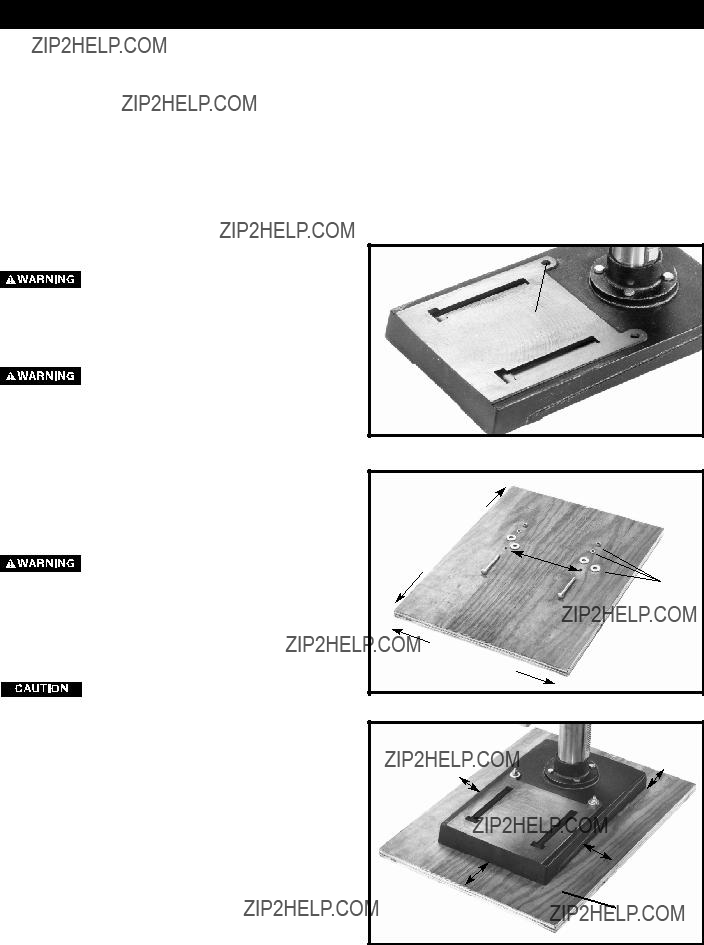
ASSEMBLY
 FOR YOUR OWN SAFETY, DO NOT CONNECT THE MACHINE TO THE POWER SOURCE UNTIL THE
FOR YOUR OWN SAFETY, DO NOT CONNECT THE MACHINE TO THE POWER SOURCE UNTIL THE
MACHINE IS COMPLETELY ASSEMBLED AND YOU READ AND UNDERSTAND THE ENTIRE INSTRUCTION
MANUAL.
ASSEMBLY TOOLS REQUIRED
* 3mm and 5mm hex wrenches (supplied) * 13mm and 17mm socket wrenches (not supplied) * Soft tip hammer (not supplied)
ASSEMBLY TIME ESTIMATE 2 - 3 hours.
1. If your drill press is to be used in a permanent location, the drill press base must be secured to the supporting surface with fasteners through the two mounting holes, (A) Fig. 3, in the drill press base.
IF YOU DO NOT FASTEN YOUR DRILL
PRESS IN A PERMANENT MANNER, THE DRILL
PRESS MUST BE FASTENED TO A PLYWOOD
MOUNTING BOARD TO PREVENT THE DRILL PRESS
FROM TIPPING OVER DURING NORMAL USE.
USE A GOOD GRADE OF PLYWOOD
WITH A MINIMUM 3/4" THICKNESS. DO NOT MAKE
THE MOUNTING BOARD FROM PARTICLE BOARD
SINCE PARTICLE BOARD BREAKS EASILY.
2.Use a plywood board base, with the minimum dimensions as shown in Fig. 4 for mounting the drill press base to a supporting surface.
3.Place the drill press base (D) Fig. 5, centered on the supporting surface (E).
MAKE SURE THERE IS AT LEAST 3"
ON ALL FOUR SIDES OF THE BASE AS SHOWN IN FIG. 5.
4. Drill two 3/8" diameter holes through the holes (A) Fig. 3 in the drill press base, and in the supporting surface (E) Fig. 5.
PLACE A PIECE OF SCRAP WOOD
UNDERNEATH THE SUPPORTING SURFACE WHEN
DRILLING THE THROUGH HOLES SO THAT THE
DRILL BIT WILL NOT DAMAGE THE MATERIAL
BENEATH THE SUPPORTING SURFACE.
5. Fasten the drill press base to the mounting board using the carriage bolts, flat washers, lockwashers, and hex nuts (C) Fig. 4, furnished with your drill press. The holes for the carriage bolt heads and flat washers under the board must be countersunk so that the bolt heads are flush or below the bottom surface of the board. Make sure to use a flat washer, lock washer and hex nut above the drill press base as shown at (F) Fig. 5.
A
Fig. 3
 C
C
Fig. 4
3" MINIMUM
3" MINIMUM
D F
F
3" MINIMUM
3" MINIMUM
E
Fig. 5
10
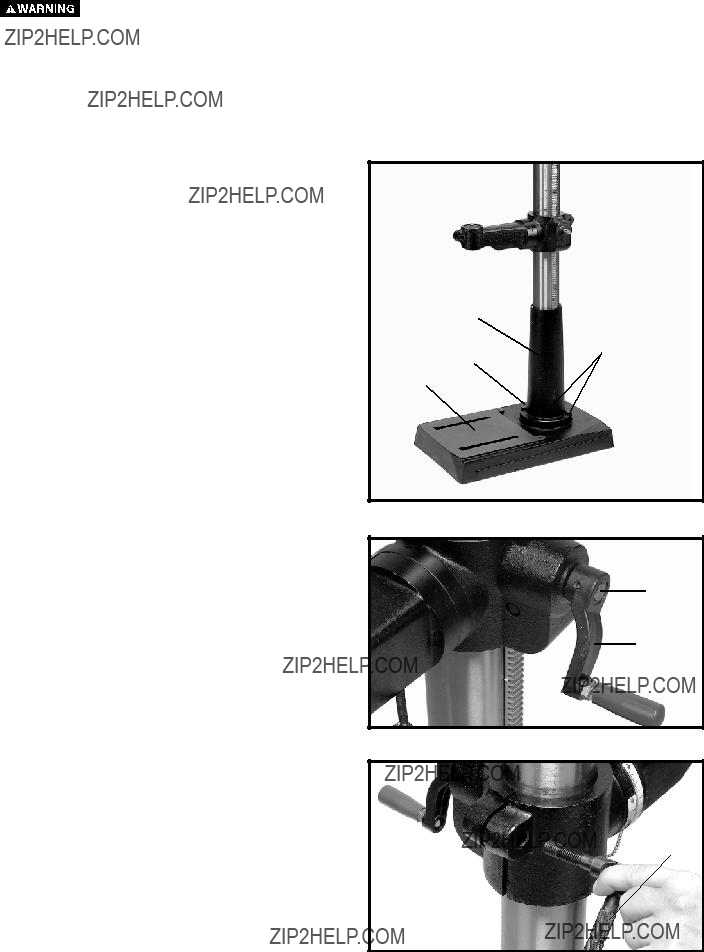
THE PLYWOOD BASE MUST BE
SECURED TO THE FLOOR OR SUPPORTING
SURFACE IF THERE IS ANY TENDENCY OF THE
DRILL PRESS TO VIBRATE, SLIDE OR WALK
DURING NORMAL OPERATION.
6. Assemble the column (A) Fig. 6, to the base (B) using the four M10x40mm hex head screws (C), three of which are shown.
7. Assemble table raising and lowering handle (D) Fig. 7, to worm gear shaft (E) and tighten screw (F) against flat on shaft with 3mm wrench supplied.
8. Thread table clamp handle (G) Fig. 8, into hole in rear of table bracket, as shown.
A
C
C
B
Fig. 6
 F
F
E
D
Fig. 7
G
Fig. 8
11

9. Insert table (H) Fig. 9, into hole in table bracket as shown.
10. Thread table locking lever (J) Fig. 10, into hole in front of table bracket as shown.
11.Place the drill press head (K) Fig. 11, onto the column as far as it will go. Align head (K) Fig. 12, with table (L) Fig. 12, and base (M) Fig. 12, and tighten the two head locking screws (N) Fig. 11 with the 5mm wrench supplied.
12.IMPORTANT: Make certain the tapered hole in the bottom of spindle (T) Fig. 13, and the taper on spindle adapter (U) are clean and free of any grease, lacquer or rust preventive coatings. NOTE: If necessary, household oven cleaner can effectively remove these coatings from the spindle and spindle adapter; however, carefully follow the manufacturer???s safety rules regarding its use.
13.Push spindle adapter (U) Fig. 13, up into spindle (T) making certain the tang (V) engages the mating slot inside spindle (T).
K
L
M
Fig. 12
H
Fig. 9
J
Fig. 10
N
K
Fig. 11
T
V
U
Fig. 13
12

14.IMPORTANT: Make certain the spindle taper (O) Fig. 14, and tapered hole in chuck (P) are clean and free of any grease, lacquer or rust preventive coatings. NOTE: Household oven cleaner can effectively remove any sub- stance from the chuck; however, carefully follow the manufacturer's safety rules concerning its use.
15.IMPORTANT: OPEN THE CHUCK JAWS AS WIDE
AS POSSIBLE MAKING SURE THE CHUCK JAWS
ARE INSIDE THE CHUCK.
16. Holding chuck on taper of spindle, tap with a soft tip hammer (Q) or a block of wood and hammer to set chuck, as shown in Fig. 15.
 To avoid damage to the chuck, NEVER drive the chuck onto the spindle with a metal hammer.
To avoid damage to the chuck, NEVER drive the chuck onto the spindle with a metal hammer.
17. Thread the three pinion shaft handles (R) into the three holes located in the pinion shaft hub (S), as shown in Fig. 16.
O
P
Fig. 14
 Q
Q
Fig. 15
S
R
R
Fig. 16
13
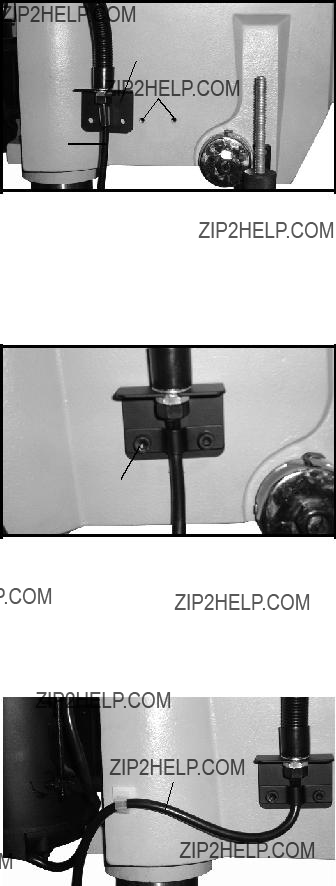
18.Align the two holes in the lamp bracket (A) Fig. 17, with the two holes (B) on the side of the drill press head.
19.Place the cord bushing (C) Fig. 17, around the top of the lamp cord (D).
20.Align the two holes in the lamp cord bracket (F) Fig.
18with the two holes in the lamp bracket (A) and drill press head.
21.Place a 1/4" washer onto a M6x1x12mm cap head screw. Insert the screw (G) Fig. 18 through the hole in the cord strain relief bracket and the lamp bracket and thread the screw into the drill press head. Repeat this process for the remaining hole in the cord strain relief bracket and tighten both screws securely.
A
B
C
D
Fig. 17
 A
A
F
G
Fig. 18
Fig. 19
14
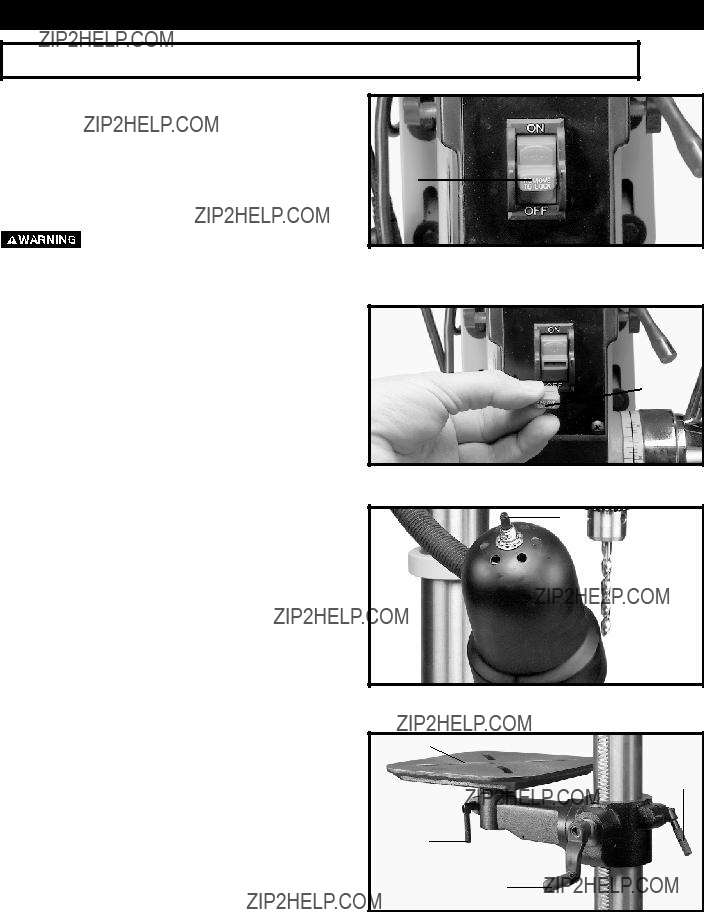
OPERATIONS
OPERATIONAL CONTROLS AND ADJUSTMENTS
STARTING AND STOPPING
DRILL PRESS
The switch (A) Fig. 20, is located on the front of the drill press head. To turn the drill press ???ON??? move the switch up to the ???ON??? position. To turn the drill press ???OFF??? move the switch down to the ???OFF??? position.
MAKE SURE THAT THE SWITCH IS IN
THE ???OFF??? POSITION BEFORE PLUGGING IN THE
POWER CORD. IN THE EVENT OF A POWER FAILURE,
MOVE THE SWITCH TO THE ???OFF??? POSITION. AN
ACCIDENTAL
LOCKING SWITCH IN
THE ???OFF??? POSITION
IMPORTANT: When the machine is not in use, the switch should be locked in the ???OFF??? position to prevent unauthorized use. This can be done by grasping the switch toggle (B) and pulling it out of the switch, as shown in Fig. 21. With the switch toggle (B) removed, the switch will not operate. However, should the switch toggle be removed while the drill press is operating, the switch can be turned ???OFF??? once, but cannot be restarted without inserting the switch toggle (B).
FLEXIBLE LAMP
The flexible lamp operates independently of the drill press. To turn the lamp ???ON??? and ???OFF???, rotate switch
(A) Fig. 22.
 To reduce the risk of fire, use 40 watt or less, 120 volt, reflector track type light bulb (not supplied). A standard household light bulb should not be used. The reflector track type light bulb should not extend below the lamp shade.
To reduce the risk of fire, use 40 watt or less, 120 volt, reflector track type light bulb (not supplied). A standard household light bulb should not be used. The reflector track type light bulb should not extend below the lamp shade.
TABLE ADJUSTMENTS
1.The table can be raised or lowered on the drill press column by loosening the table clamp (A) Fig. 23, and turning the table raising and lowering handle (B). After the table is at the desired height, tighten clamp (A) Fig.
23.NOTE: Final positioning of the drill press table should always be from the bottom to the up position.
2.The table can be rotated 360 degrees by loosening clamp (H) Fig. 23, rotate table to desired position and tighten clamp (H).
A
Fig. 20
B
Fig. 21
A
Fig. 22
G
A
H
B
Fig. 23
15
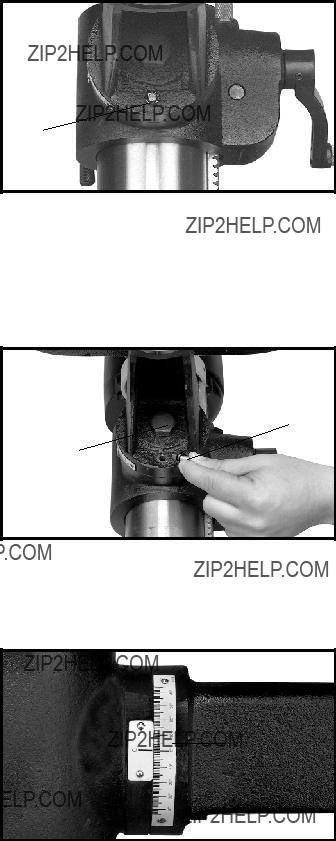
3. The table can be tilted right or left by pulling out and removing table alignment pin (C) Fig. 24. NOTE: If pin (C) is difficult to remove, turn nut (E) clockwise to pull pin out of casting.
4. Fig. 25, illustrates the table alignment pin (C) removed. Loosen table locking bolt (D), tilt table to the desired angle and tighten bolt (D). When returning table to the level position, replace table alignment pin (C). This will position the table surface at 90 degrees to the spindle.
5. A tilt scale (E) Fig. 26, is provided on the table bracket casting to indicate the degree of tilt. A witness line and zero mark (F) are also provided on the table to line up with the scale (E).
C
E
Fig. 24
C
D
Fig. 25
E
F 
Fig. 26
16

SPINDLE SPEEDS
Twelve spindle speeds are available on the drill press. Fig. 27, illustrates which steps of the pulleys the belts must be placed to obtain the twelve speeds available.
540
360
250
1090
590
410
1820
1280
650
3000
2180
1450
Fig. 27
CHANGING SPEEDS AND
ADJUSTING BELT TENSION
NOTE: A BELT POSITIONING SPEED CHART (E) FIG.
28, IS LOCATED ON THE INSIDE TOP COVER OF
THE DRILL PRESS.
 DISCONNECT MACHINE FROM POWER
DISCONNECT MACHINE FROM POWER
SOURCE.
1.Lift up the belt and pulley guard (A) Fig. 28.
2.Release belt tension by loosening tension lock knob
(B) Fig. 28, and the tension knob located on the other side of the head casting and moving tension lever (C) forward.pivoting the motor (D) toward the front of the drill press.
3.While holding the motor toward the front of the drill press, position the belts (F) on the desired steps of the motor and spindle pulleys, as shown in Figs. 27 & 28.
4.After the belts are positioned on the desired steps of the motor and spindle pulleys, move motor (D) Fig. 28, to the rear until the belt is properly tensioned and tighten tension lock knob (B). The belt should be just tight enough to prevent slipping. Excessive tension will reduce the life of the belt, pulleys and bearings. Correct tension is obtained when the belts (F) can be flexed about 1" out of line midway between the pulleys.
Fig. 28
17

DRILLING HOLES TO DEPTH
Where a number of holes are to be drilled to exactly the same depth, a depth stop is provided and is used as follows:
 DISCONNECT MACHINE FROM POWER
DISCONNECT MACHINE FROM POWER
SOURCE.
1.Install bit in chuck.
2.Loosen lock screw (A) Fig. 29, and rotate pinion assembly (B) until the pointer (C) lines up with the mark on the scale (D) you wish the depth of the holes to be drilled. Then tighten lock screw (A).
3.Place the material to be drilled on the drill press table. Raise the drill press table until the material to be drilled just touches the drill bit.
4.Drill a test hole to check the depth and adjust if necessary. All holes will then be drilled to the exact depth as indicated on scale (D) Fig. 29. NOTE: Scale (D) is calibrated in both inches and millimeters.
ADJUSTING SPINDLE
RETURN SPRING
B
D
A
C
Fig. 29
A
The spindle is automatically returned to its upper most position when the handle is released. It is recommended that the handle be allowed to slowly return to the top position after each hole has been drilled. This spring has been properly adjusted at the factory and should not be disturbed unless absolutely necessary. To adjust the return spring, proceed as follows:
B
E
 DISCONNECT MACHINE FROM POWER
DISCONNECT MACHINE FROM POWER
SOURCE.
Fig. 30
E
B
 D
D
A
Fig. 31
18

MACHINE USE
Your drill press is to be used with drill bits with a shank of 5/8" or less in diameter. The following will give the inexperienced operator a start on common drill press operations. Use scrap material for practice to get a feel of the machine before attempting regular work.
 The use of accessories and attachments not recommended by Delta may result in risk of injury.
The use of accessories and attachments not recommended by Delta may result in risk of injury.
IMPORTANT: When the workpiece is long enough it should always be positioned on the table with one end
against the left side of the column, as shown in Fig. 32.Fig. 32 This prevents the workpiece from rotating with the drill
bit or cutting tool, causing damage to the workpiece or injury to the operator. If it is not possible to support the workpiece against the column, the workpiece should always be fastened to the table using clamps or a vise.
INSTALLING AND
REMOVING DRILL BITS
 DISCONNECT MACHINE FROM POWER
DISCONNECT MACHINE FROM POWER
SOURCE.
1.Insert smooth end of drill bit (A) Fig. 33, into chuck (B), as far as it will go, and then back the bit out 1/16", or up to the flutes for small bits.
2.Make certain that the drill bit (A) Fig. 33, is centered in the chuck (B) before tightening the chuck with the key
(C).
3.Turn the chuck key (C) Fig. 33, clockwise to tighten and counterclockwise to loosen the chuck jaws.
4.Tighten all three chuck jaws to secure the drill bit sufficiently so that it does not slip while drilling.
5. MAKE SURE chuck key (C) Fig. 33, is removed from chuck before starting drill press. Your chuck key (C) is equipped with a
MAKE SURE chuck key (C) Fig. 33, is removed from chuck before starting drill press. Your chuck key (C) is equipped with a
D
B
C
A
Fig. 33
CORRECT DRILLING SPEEDS
Factors which determine the best speed to use are: kind of material being worked, size of hole, type of drill or other cutter, and quality of cut desired.
 Use the recommended speed for the drill press bit and workpiece material.
Use the recommended speed for the drill press bit and workpiece material.
19
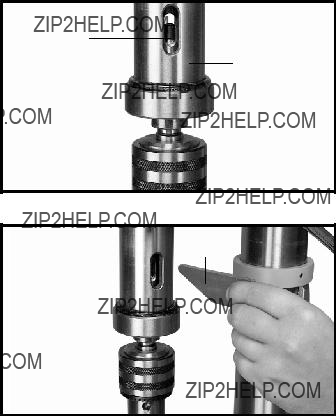
BORING IN WOOD
Twist drills, although intended for metal drilling, may also be used for boring holes in wood. However, machine spur bits are generally preferred for working in wood; they cut a flat bottom hole and are designed for removal of wood chips. Do not use hand bits which have a screw tip; at drill press speeds they turn into the wood so rapidly as to lift the work off the table and whirl it.
For through boring, line up the table so that the bit will enter the center hole to avoid damage to the table. Scribe a vertical line on the front of the column and a matching mark on the table bracket and the drill press head, so that the table and drill press head can be clamped in the center position at any height.
Feed slowly when the bit is about to cut through the wood to prevent splintering the bottom face. Use a scrap piece of wood as a base block under the work; this helps to reduce splintering and protects the point of the bit.
DRILLING METAL
Use clamps to hold the work when drilling metal. The work should never be held in the bare hand; the drill bit may seize the work at any time, especially when breaking through the stock. If the piece is whirled out of the operator's hand, the operator may be injured. The drill bit will be broken if the work strikes the column.
The work must be clamped firmly while drilling; any tilting, twisting or shifting results not only in a rough hole, but also increases drill bit breakage. For flat work, lay the piece on a wooden base and clamp it firmly down against the table to prevent it from turning. If the piece is of irregular shape and cannot be laid flat on the table, it should be securely blocked and clamped.
REMOVING SPINDLE ADAPTER
The spindle adapter and chuck can be removed for the purpose of using shanks with a #2 morse taper.
 DISCONNECT MACHINE FROM POWER
DISCONNECT MACHINE FROM POWER
SOURCE.
1. Align the slot in the quill (A) Fig. 34, with the slot in the spindle (B).
2.Insert the spindle adapter remover (C) Fig. 35, through the slot in the quill and the slot in the spindle.
3.Tap the spindle adapter remover (C) Fig. 35, with a hammer until the the spindle adapter and chuck fall out from the quill.
B
A
Fig. 34
C
Fig. 35
20

TROUBLESHOOTING
For assistance with your machine, visit our website at www.deltamachinery.com for a list of service centers or call the DELTA Machinery help line at
21

MAINTENANCE
KEEP MACHINE CLEAN
Periodically blow out all air passages with dry compressed air. All plastic parts should be cleaned with a soft damp cloth. NEVER use solvents to clean plastic parts. They could possibly dissolve or otherwise damage the material.
Wear ANSI Z87.1 safety glasses while using compressed air.
FAILURE TO START
Should your machine fail to start, check to make sure the prongs on the cord plug are making good contact in the outlet. Also, check for blown fuses or open circuit breakers in the line.
LUBRICATION
Apply household floor paste wax to the machine table and extension table or other work surface weekly.
PROTECTING CAST IRON FROM RUST
To clean and protect cast iron tables from rust, you will need the following materials: 1 pushblock from a jointer, 1 sheet of medium
SERVICE
PARTS, SERVICE OR WARRANTY ASSISTANCE
All Delta Machines and accessories are manufactured to high quality standards and are serviced by a network of
ACCESSORIES
A complete line of accessories is available from your Delta Supplier,
for the name of your nearest supplier.
 Since accessories other than those offered by Delta have not been tested with this product, use of such accessories could be hazardous. For safest operation, only Delta recommended accessories should be used with this product.
Since accessories other than those offered by Delta have not been tested with this product, use of such accessories could be hazardous. For safest operation, only Delta recommended accessories should be used with this product.
WARRANTY
Two Year Limited New Product Warranty
Delta will repair or replace, at its expense and at its option, any new Delta machine, machine part, or machine accessory which in normal use has proven to be defective in workmanship or material, provided that the customer returns the product prepaid to a Delta factory service center or authorized service station with proof of purchase of the product within two years and provides Delta with reasonable opportunity to verify the alleged defect by inspection. For all refurbished Delta product, the warranty period is 180 days. Delta may require that electric motors be returned prepaid to a motor manufacturer???s authorized station for inspection and repair or replacement. Delta will not be responsible for any asserted defect which has resulted from normal wear, misuse, abuse or repair or alteration made or specifically authorized by anyone other than an authorized Delta service facility or representative. Under no circumstances will Delta be liable for incidental or consequential damages resulting from defective products. This warranty is Delta???s sole warranty and sets forth the customer???s exclusive remedy, with respect to defective products; all other warranties, express or implied, whether of merchantability, fitness for purpose, or otherwise, are expressly disclaimed by Delta.
22

(CENTROS DE SERVICIO DE
Parts and Repair Service for
Authorized Service Stations are located in many large cities. Telephone
CANADIAN
The following are trademarks of
TORQBUSTER??,
Trademarks noted with ??? and ?? are registered in the United States Patent and Trademark Office and may also be registered in other countries. Las Marcas Registradas con el signo de ??? y ?? son registradas por la Oficina de Registros y Patentes de los Estados Unidos y tambi??n pueden estar